本帖最后由 PeersLee 于 2017-1-18 11:50 编辑
问题导读:
1. 如何搭建准备环境?
2. 如何搭建运行环境?
3. 如何处理数据?

上一篇:Spark机器学习入门·编程(scala/java/python)实现分析商店购买记录
解决方案:
环境准备:
anaconda
[mw_shl_code=shell,true]nano ~/.zshrc
export PATH=$PATH:/anaconda/bin
source ~/.zshrc
echo $HOME
echo $PATH[/mw_shl_code]
ipython
[mw_shl_code=shell,true]conda update conda && conda update ipython ipython-notebook ipython-qtconsole
conda install scipy[/mw_shl_code]
PYTHONPATH
[mw_shl_code=shell,true]export SPARK_HOME=/Users/erichan/garden/spark-1.5.1-bin-hadoop2.6
export PYTHONPATH=${SPARK_HOME}/python/:${SPARK_HOME}/python/lib/py4j-0.8.2.1-src.zip[/mw_shl_code]
运行环境:
[mw_shl_code=shell,true]cd $SPARK_HOME
IPYTHON=1 IPYTHON_OPTS="--pylab" ./bin/pyspark[/mw_shl_code]
数据:
1. 获取原始数据
[mw_shl_code=shell,true]PATH = "/Users/erichan/sourcecode/book/Spark机器学习"
user_data = sc.textFile("%s/ml-100k/u.user" % PATH)
user_fields = user_data.map(lambda line: line.split("|"))
movie_data = sc.textFile("%s/ml-100k/u.item" % PATH)
movie_fields = movie_data.map(lambda lines: lines.split("|"))
rating_data_raw = sc.textFile("%s/ml-100k/u.data" % PATH)
rating_data = rating_data_raw.map(lambda line: line.split("\t"))[/mw_shl_code]
[mw_shl_code=scala,true]num_movies = movie_data.count()
print num_movies[/mw_shl_code]
1682
[mw_shl_code=shell,true]user_data.first()[/mw_shl_code]
u'1|24|M|technician|85711'
[mw_shl_code=shell,true]movie_data.first()[/mw_shl_code]
u'1|Toy Story (1995)|01-Jan-1995||http://us.imdb.com/M/title-exact?Toy%20Story%20(1995)|0|0|0|1|1|1|0|0|0|0|0|0|0|0|0|0|0|0|0'
[mw_shl_code=shell,true]rating_data_raw.first()[/mw_shl_code]
u'196\t242\t3\t881250949'
2. 探索数据
2.1. 按列统计
[mw_shl_code=scala,true]num_users = user_fields.map(lambda fields: fields[0]).count()
num_genders = user_fields.map(lambda fields: fields[2]).distinct().count()
num_occupations = user_fields.map(lambda fields: fields[3]).distinct().count()
num_zipcodes = user_fields.map(lambda fields: fields[4]).distinct().count()
ratings = rating_data.map(lambda fields: int(fields[2]))
num_ratings = ratings.count()
max_rating = ratings.reduce(lambda x, y: max(x, y))
min_rating = ratings.reduce(lambda x, y: min(x, y))
mean_rating = ratings.reduce(lambda x, y: x + y) / float(num_ratings)
median_rating = np.median(ratings.collect())
ratings_per_user = num_ratings / num_users
ratings_per_movie = num_ratings / num_movies
print "Users: %d, genders: %d, occupations: %d, ZIP codes: %d" % (num_users, num_genders, num_occupations, num_zipcodes)[/mw_shl_code]
Users: 943, genders: 2, occupations: 21, ZIP codes: 795
[mw_shl_code=scala,true]print "Min rating: %d" % min_rating[/mw_shl_code]
Min rating: 1
[mw_shl_code=scala,true]print "Max rating: %d" % max_rating[/mw_shl_code]
Max rating: 5
[mw_shl_code=scala,true]print "Average rating: %2.2f" % mean_rating[/mw_shl_code]
Average rating: 3.53
[mw_shl_code=scala,true]print "Median rating: %d" % median_rating[/mw_shl_code]
Median rating: 4
[mw_shl_code=scala,true]print "Average # of ratings per user: %2.2f" % ratings_per_user[/mw_shl_code]
Average # of ratings per user: 106.00
[mw_shl_code=scala,true]print "Average # of ratings per movie: %2.2f" % ratings_per_movie[/mw_shl_code]
Average # of ratings per movie: 59.00
[mw_shl_code=scala,true]ratings.stats()[/mw_shl_code]
(count: 100000, mean: 3.52986, stdev: 1.12566797076, max: 5, min: 1)
2.2. 使用matplotlib的hist函数绘制直方图
[mw_shl_code=scala,true]ages = user_fields.map(lambda x: int(x[1])).collect()
hist(ages, bins=20, color='lightblue', normed=True)
fig = matplotlib.pyplot.gcf()
fig.set_size_inches(16, 10)[/mw_shl_code]
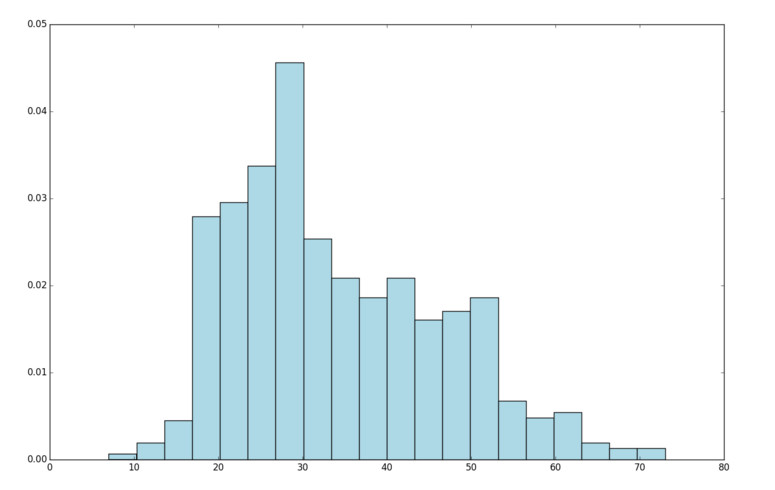
[mw_shl_code=scala,true]count_by_rating = ratings.countByValue()
x_axis = np.array(count_by_rating.keys())
y_axis = np.array([float(c) for c in count_by_rating.values()])
# we normalize the y-axis here to percentages
y_axis_normed = y_axis / y_axis.sum()
pos = np.arange(len(x_axis))
width = 1.0
ax = plt.axes()
ax.set_xticks(pos + (width / 2))
ax.set_xticklabels(x_axis)
plt.bar(pos, y_axis_normed, width, color='lightblue')
plt.xticks(rotation=30)
fig = matplotlib.pyplot.gcf()
fig.set_size_inches(16, 10)[/mw_shl_code]
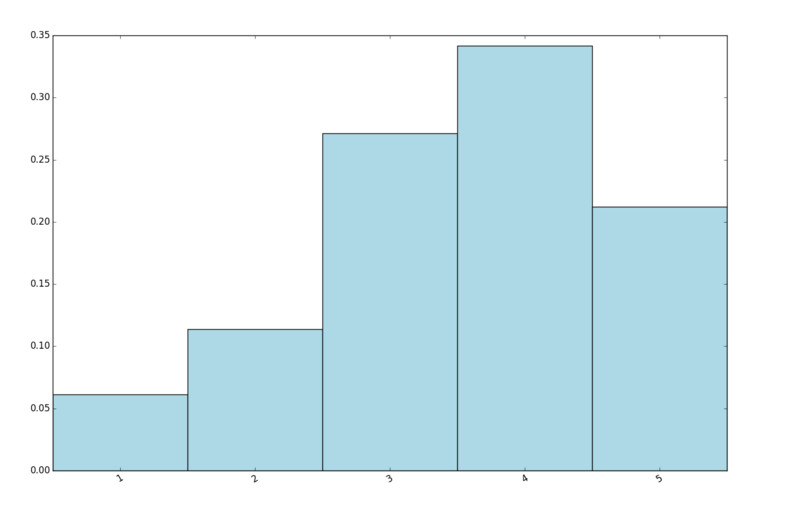
[mw_shl_code=scala,true]count_by_occupation = user_fields.map(lambda fields: (fields[3], 1)).reduceByKey(lambda x, y: x + y).collect()
x_axis1 = np.array([c[0] for c in count_by_occupation])
y_axis1 = np.array([c[1] for c in count_by_occupation])
x_axis = x_axis1[np.argsort(y_axis1)]
y_axis = y_axis1[np.argsort(y_axis1)]
pos = np.arange(len(x_axis))
width = 1.0
ax = plt.axes()
ax.set_xticks(pos + (width / 2))
ax.set_xticklabels(x_axis)
plt.bar(pos, y_axis, width, color='lightblue')
plt.xticks(rotation=30)
fig = matplotlib.pyplot.gcf()
fig.set_size_inches(16, 10)[/mw_shl_code]
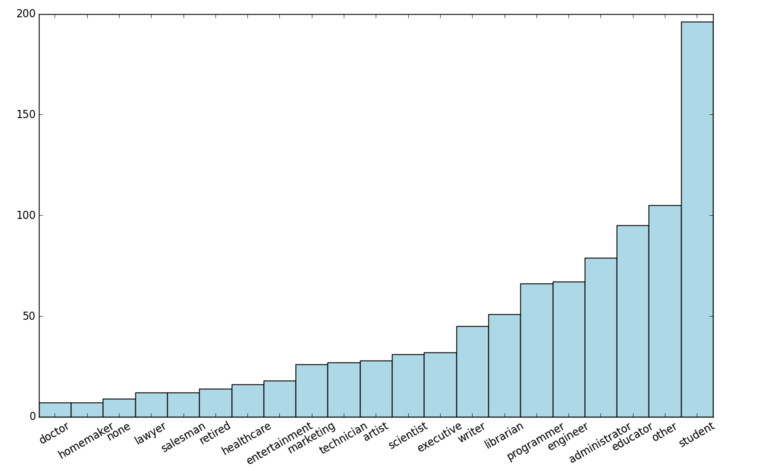
2.3. 使用countByValue函数统计
[mw_shl_code=scala,true]count_by_occupation2 = user_fields.map(lambda fields: fields[3]).countByValue()
print "Map-reduce approach:"
print dict(count_by_occupation2)[/mw_shl_code]
{u'administrator': 79, u'retired': 14, u'lawyer': 12, u'healthcare': 16, u'marketing': 26, u'executive': 32, u'scientist': 31, u'student': 196, u'technician': 27, u'librarian': 51, u'programmer': 66, u'salesman': 12, u'homemaker': 7, u'engineer': 67, u'none': 9, u'doctor': 7, u'writer': 45, u'entertainment': 18, u'other': 105, u'educator': 95, u'artist': 28}
[mw_shl_code=scala,true]print ""
print "countByValue approach:"
print dict(count_by_occupation)[/mw_shl_code]
{u'administrator': 79, u'writer': 45, u'retired': 14, u'lawyer': 12, u'doctor': 7, u'marketing': 26, u'executive': 32, u'none': 9, u'entertainment': 18, u'healthcare': 16, u'scientist': 31, u'student': 196, u'educator': 95, u'technician': 27, u'librarian': 51, u'programmer': 66, u'artist': 28, u'salesman': 12, u'other': 105, u'homemaker': 7, u'engineer': 67}
2.4. 使用filter转换
[mw_shl_code=scala,true]def convert_year(x):
try:
return int(x[-4:])
except:
return 1900
years = movie_fields.map(lambda fields: fields[2]).map(lambda x: convert_year(x))
years_filtered = years.filter(lambda x: x != 1900)
movie_ages = years_filtered.map(lambda yr: 1998-yr).countByValue()
values = movie_ages.values()
bins = movie_ages.keys()
hist(values, bins=bins, color='lightblue', normed=True)[/mw_shl_code]
(array([ 0. , 0.07575758, 0.09090909, 0.09090909, 0.18181818,
0.18181818, 0.04545455, 0.07575758, 0.07575758, 0.03030303,
0. , 0.01515152, 0.01515152, 0.03030303, 0. ,
0.03030303, 0. , 0. , 0. , 0. ,
0. , 0. , 0.01515152, 0. , 0.01515152,
0. , 0. , 0. , 0. , 0. ,
0. , 0. , 0. , 0. , 0. ,
0. , 0. , 0.01515152, 0. , 0. ,
0. , 0. , 0. , 0. , 0. ,
0. , 0. , 0. , 0. , 0. ,
0. , 0. , 0. , 0. , 0. ,
0. , 0. , 0. , 0. , 0. ,
0. , 0. , 0. , 0. , 0. ,
0.01515152, 0. , 0. , 0. , 0. ]),
array([ 0, 1, 2, 3, 4, 5, 6, 7, 8, 9, 10, 11, 12, 13, 14, 15, 16,
17, 18, 19, 20, 21, 22, 23, 24, 25, 26, 27, 28, 29, 30, 31, 32, 33,
34, 35, 36, 37, 38, 39, 40, 41, 42, 43, 44, 45, 46, 47, 48, 49, 50,
51, 52, 53, 54, 55, 56, 57, 58, 59, 60, 61, 62, 63, 64, 65, 66, 67,
68, 72, 76]),
)
[mw_shl_code=scala,true]fig = matplotlib.pyplot.gcf()
fig.set_size_inches(16,10)[/mw_shl_code]
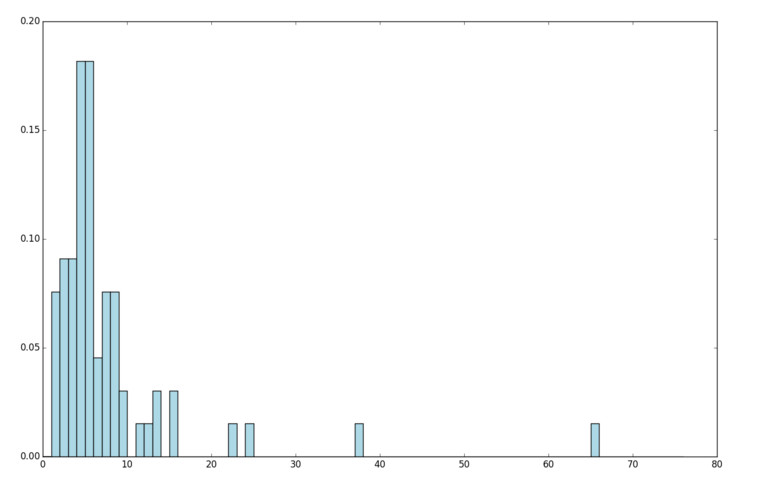
2.5. 使用groupByKey分组
[mw_shl_code=scala,true]# to compute the distribution of ratings per user, we first group the ratings by user id
user_ratings_grouped = rating_data.map(lambda fields: (int(fields[0]), int(fields[2]))).groupByKey()
# then, for each key (user id), we find the size of the set of ratings, which gives us the # ratings for that user
user_ratings_byuser = user_ratings_grouped.map(lambda (k, v): (k, len(v)))
user_ratings_byuser.take(5)[/mw_shl_code]
[(2, 62), (4, 24), (6, 211), (8, 59), (10, 184)]
[mw_shl_code=scala,true]user_ratings_byuser_local = user_ratings_byuser.map(lambda (k, v): v).collect()
hist(user_ratings_byuser_local, bins=200, color='lightblue', normed=True)[/mw_shl_code]
[mw_shl_code=scala,true]fig = matplotlib.pyplot.gcf()
fig.set_size_inches(16,10)[/mw_shl_code]
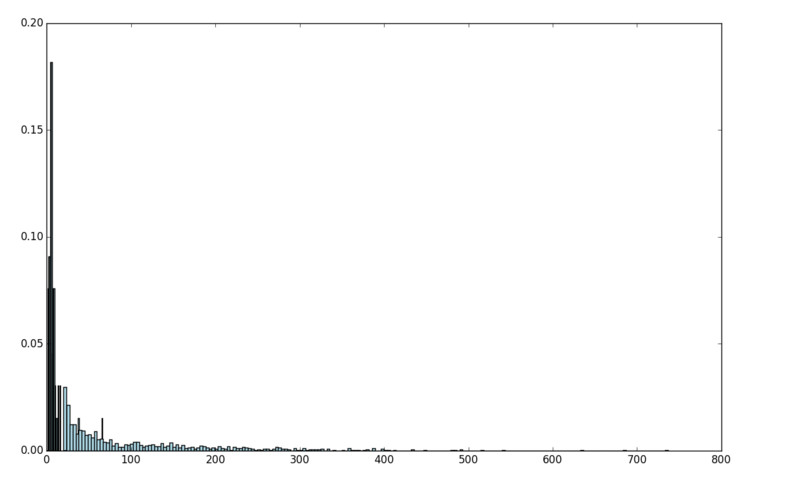
3. 处理转换
3.1. 填充缺失
[mw_shl_code=shell,true]years_pre_processed = movie_fields.map(lambda fields: fields[2]).map(lambda x: convert_year(x)).filter(lambda yr: yr != 1900).collect()
years_pre_processed_array = np.array(years_pre_processed)
# first we compute the mean and median year of release, without the 'bad' data point
mean_year = np.mean(years_pre_processed_array[years_pre_processed_array!=1900])
median_year = np.median(years_pre_processed_array[years_pre_processed_array!=1900])
idx_bad_data = np.where(years_pre_processed_array==1900)[0]
years_pre_processed_array[idx_bad_data] = median_year
print "Mean year of release: %d" % mean_year[/mw_shl_code]
Mean year of release: 1989
[mw_shl_code=scala,true]print "Median year of release: %d" % median_year[/mw_shl_code]
Median year of release: 1995
[mw_shl_code=shell,true]print "Index of '1900' after assigning median: %s" % np.where(years_pre_processed_array == 1900)[0][/mw_shl_code]
Index of '1900' after assigning median: []
4. 提取特征
4.1. 类别特征(norminal变量/ordinal变量)
[mw_shl_code=scala,true]all_occupations = user_fields.map(lambda fields: fields[3]).distinct().collect()
all_occupations.sort()
# create a new dictionary to hold the occupations, and assign the "1-of-k" indexes
idx = 0
all_occupations_dict = {}
for o in all_occupations:
all_occupations_dict[o] = idx
idx +=1
# try a few examples to see what "1-of-k" encoding is assigned
print "Encoding of 'doctor': %d" % all_occupations_dict['doctor']
print "Encoding of 'programmer': %d" % all_occupations_dict['programmer'][/mw_shl_code]
Encoding of 'doctor': 2
Encoding of 'programmer': 14
[mw_shl_code=python,true]K = len(all_occupations_dict)
binary_x = np.zeros(K)
k_programmer = all_occupations_dict['programmer']
binary_x[k_programmer] = 1
print "Binary feature vector: %s" % binary_x
print "Length of binary vector: %d" % K[/mw_shl_code]
Binary feature vector: [ 0. 0. 0. 0. 0. 0. 0. 0. 0. 0. 0. 0. 0. 0. 1. 0. 0. 0.
0. 0.] Length of binary vector: 21
4.2. 派生特征
时间戳转换为类别特征
[mw_shl_code=scala,true]def extract_datetime(ts):
import datetime
return datetime.datetime.fromtimestamp(ts)
def assign_tod(hr):
times_of_day = {
'morning' : range(7, 12),
'lunch' : range(12, 15),
'afternoon' : range(15, 18),
'evening' : range(18, 23),
'night' : {23,24,0,1,2,3,4,5,6,7}
}
for k, v in times_of_day.iteritems():
if hr in v:
return k
timestamps = rating_data.map(lambda fields: int(fields[3]))
hour_of_day = timestamps.map(lambda ts: extract_datetime(ts).hour)
# now apply the "time of day" function to the "hour of day" RDD
time_of_day = hour_of_day.map(lambda hr: assign_tod(hr))
timestamps.take(5)[/mw_shl_code]
[881250949, 891717742, 878887116, 880606923, 886397596]
[mw_shl_code=scala,true]hour_of_day.take(5)[/mw_shl_code]
[23, 3, 15, 13, 13]
[mw_shl_code=scala,true]time_of_day.take(5)[/mw_shl_code]
['night', 'night', 'afternoon', 'lunch', 'lunch']
4.3. 文本特征
[mw_shl_code=scala,true]def extract_title(raw):
import re
grps = re.search("\((\w+)\)", raw)
if grps:
return raw[:grps.start()].strip()
else:
return raw
raw_titles = movie_fields.map(lambda fields: fields[1])
for raw_title in raw_titles.take(5):
print extract_title(raw_title)[/mw_shl_code]
Toy Story
GoldenEye
Four Rooms
Get Shorty
Copycat
[mw_shl_code=scala,true]movie_titles = raw_titles.map(lambda m: extract_title(m))
# next we tokenize the titles into terms. We'll use simple whitespace tokenization
title_terms = movie_titles.map(lambda t: t.split(" "))
print title_terms.take(5)[/mw_shl_code]
[[u'Toy', u'Story'], [u'GoldenEye'], [u'Four', u'Rooms'], [u'Get', u'Shorty'], [u'Copycat']]
flatMap
[mw_shl_code=scala,true]all_terms = title_terms.flatMap(lambda x: x).distinct().collect()
# create a new dictionary to hold the terms, and assign the "1-of-k" indexes
idx = 0
all_terms_dict = {}
for term in all_terms:
all_terms_dict[term] = idx
idx +=1
num_terms = len(all_terms_dict)
print "Total number of terms: %d" % num_terms[/mw_shl_code]
Total number of terms: 2645
print "Index of term 'Dead': %d" % all_terms_dict['Dead']
Index of term 'Dead': 147
[mw_shl_code=scala,true]print "Index of term 'Rooms': %d" % all_terms_dict['Rooms'][/mw_shl_code]
Index of term 'Rooms': 1963
zipWithIndex
[mw_shl_code=scala,true]all_terms_dict2 = title_terms.flatMap(lambda x: x).distinct().zipWithIndex().collectAsMap()
print "Index of term 'Dead': %d" % all_terms_dict2['Dead']
print "Index of term 'Rooms': %d" % all_terms_dict2['Rooms'][/mw_shl_code]
Index of term 'Dead': 147
Index of term 'Rooms': 1963
创建稀疏向量/广播变量
scipy depends $PYTHONPATH
[mw_shl_code=scala,true]def create_vector(terms, term_dict):
from scipy import sparse as sp
x = sp.csc_matrix((1, num_terms))
for t in terms:
if t in term_dict:
idx = term_dict[t]
x[0, idx] = 1
return x
all_terms_bcast = sc.broadcast(all_terms_dict)
term_vectors = title_terms.map(lambda terms: create_vector(terms, all_terms_bcast.value))
term_vectors.take(5)[/mw_shl_code]
[<1x2645 sparse matrix of type ''
with 1 stored elements in Compressed Sparse Column format>,
<1x2645 sparse matrix of type ''
with 1 stored elements in Compressed Sparse Column format>,
<1x2645 sparse matrix of type ''
with 1 stored elements in Compressed Sparse Column format>,
<1x2645 sparse matrix of type ''
with 1 stored elements in Compressed Sparse Column format>,
<1x2645 sparse matrix of type ''
with 1 stored elements in Compressed Sparse Column format>]
4.4. 正则化特征
[mw_shl_code=scala,true]np.random.seed(42)
x = np.random.randn(10)
norm_x_2 = np.linalg.norm(x)
normalized_x = x / norm_x_2
print "x:\n%s" % x
print "2-Norm of x: %2.4f" % norm_x_2
print "Normalized x:\n%s" % normalized_x
print "2-Norm of normalized_x: %2.4f" % np.linalg.norm(normalized_x)[/mw_shl_code]
x:
[ 0.49671415 -0.1382643 0.64768854 1.52302986 -0.23415337 -0.23413696
1.57921282 0.76743473 -0.46947439 0.54256004]
2-Norm of x: 2.5908
Normalized x:
[ 0.19172213 -0.05336737 0.24999534 0.58786029 -0.09037871 -0.09037237
0.60954584 0.29621508 -0.1812081 0.20941776]
2-Norm of normalized_x: 1.0000
[mw_shl_code=scala,true]from pyspark.mllib.feature import Normalizer
normalizer = Normalizer()
vector = sc.parallelize([x])
normalized_x_mllib = normalizer.transform(vector).first().toArray()
print "x:\n%s" % x
print "2-Norm of x: %2.4f" % norm_x_2
print "Normalized x MLlib:\n%s" % normalized_x_mllib
print "2-Norm of normalized_x_mllib: %2.4f" % np.linalg.norm(normalized_x_mllib)[/mw_shl_code]
x:
[ 0.49671415 -0.1382643 0.64768854 1.52302986 -0.23415337 -0.23413696
1.57921282 0.76743473 -0.46947439 0.54256004]
2-Norm of x: 2.5908
Normalized x MLlib:
[ 0.19172213 -0.05336737 0.24999534 0.58786029 -0.09037871 -0.09037237
0.60954584 0.29621508 -0.1812.20941776]
2-Norm of normalized_x_mllib: 1.0000
转自:云栖社区
作者:刘翁
|
 /2
/2 